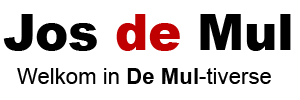Esthetische ontwikkeling in genetisch-structuralistisch perspectief
Jos de Mul. Esthetische ontwikkeling in genetisch-structuralistisch perspectief. In: J.R.M. Gerris (red.) Pedagogisch onderzoek in ontwikkeling, Nijmegen: Uitgave Subfaculteit der Pedagogische Wetenschappen, 1986, 149-164.
Genetic structuralism and conceptual relativism
Jos de Mul. Genetic structuralism and conceptual relativism. In: Paul Weingartner & Gerhard Schurz, Berichte des 11. Internationalen Wittgenstein-Symposium, Wien (Hölder-Pichler-Tempsky), 1987, 31-34.
Diltheys narratieve model van de menselijke ontwikkeling en de filosofische hermeneutiek van Heidegger en Gadamer
Jos de Mul. Diltheys narratieve model van de menselijke ontwikkeling en de filosofische hermeneutiek van Heidegger en Gadamer. In: G. Vandenacker (et.al), Congresbundel Filosofendag Utrecht 1989, Delft: Eburon, 1990, 133-141.
Vrede en gelatenheid. Over Heidegger, postmodernisme en vredescultuur
Jos de Mul. Vrede en gelatenheid. Over Heidegger, postmodernisme en vredescultuur. In: J. van Weerden en Th. Bolleman (eds.), Postmodernisme en Vredescultuur, Utrecht: Uitgave Studium Generale, 1989, 15-50.
Fotografie als metafysica
Jos de Mul. Fotografie als metafysica. In: O. van Alphen en H. Visser (red.), Een woord voor het beeld. Opstellen over fotografie, Amsterdam: SUA, 1989, 68-104.
Wijsgerige antropologie na "de dood van de mens". Heidegger en de ecologische crisis
Jos de Mul. Wijsgerige antropologie na "de dood van de mens". Heidegger en de ecologische crisis. In: D. Tiemersma (red.),Filosofie, maatschappij en universiteit. Feestbundel voor Jan Sperna Weiland, Baarn: Ambo, 1990, 66-100.
Waarom esthetische opvoeding, waarom literatuuronderwijs?
Jos de Mul. Waarom esthetische opvoeding, waarom literatuuronderwijs? in: W.A.M. de Moor (ed.), Stiefkind en Bottleneck. De Toetsing in het literatuuronderwijs, Nijmegen (Uitgave Vakgroep Algemene Kunstwetenschappen) 1990, 47-56.
Wanneer men het thema toetsing ter sprake brengt, stuit men vroeg of laat op de vraag naar het waarom van het literatuuronderwijs. Als we deze waaromvraag stellen, vragen we om een rechtvaardiging van het literatuuronderwijs. We vragen in zo'n geval naar de redenen die ons ingeven om tijd en aandacht en dat betekent in onderwijspolitieke termen dus ook steeds geld, te besteden aan het literatuuronderwijs.
Met betrekking tot het literatuuronderwijs laten zich globaal twee typen rechtvaardiging onderscheiden, die ik zou willen aanduiden als instrumentele en intrinsieke vormen van rechtvaardiging.
In het geval van een instrumentele rechtvaardiging wordt het literatuuronderwijs niet opgevat als een doel op zich, maar als een instrument voor een verdergelegen doel. Bijvoorbeeld ten behoeve van de bevordering van de leesvaardigheid of, in geval het gaat om literatuuronderwijs in een vreemde taal, ten behoeve van de bevordering van de beheersing van deze taal.
Indien we daarentegen spreken over een intrinsieke rechtvaardiging van het literatuuronderwijs, hebben we het over de rechtvaardiging van het literatuuronderwijs als doel op zich. In dat geval zal de aandacht in de rechtvaardiging zich vooral richten op de esthetische dimensie van het literatuuronderwijs. De vraag naar de rechtvaardiging van het literatuuronderwijs wordt dan opgevat als een deel van de vraag naar de rechtvaardiging van de esthetische opvoeding.
In mijn bijdrage wil ik speciaal op deze laatste vorm van rechtvaardiging van het literatuuronderwijs ingaan: op de rechtvaardiging van het literatuuronderwijs als onderdeel van de esthetische opvoeding. Daarmee begeef ik mij, om ten minste twee redenen op glad ijs. In de eerste plaats vooronderstelt een rechtvaardiging van de esthetische opvoeding een heldere opvatting van wat esthetische opvoeding eigenlijk is. Als we ons echter naar de pedagogische literatuur wenden om ons hieromtrent nader te oriënteren, is deze helderheid ver te zoeken. Betty Redfem, een vooraanstaande auteur op het gebied van de esthetische opvoeding, vatte de stand van zaken in haar onlangs gepubliceerde inleiding in de esthetische opvoeding als volgt samen: 'Het is wellicht niet overdreven te stellen dat er noch in de opvoedkundige praktijk, noch in de opvoedkundige theorie meer verwarring bestaat dan over esthetische opvoeding. Een groot deel van wat hierover in de literatuur is te vinden, en dat geldt <K)k en niet in de laatste plaats voor officiële rapporten en onderzoeken, is vititj’, van misverstanden en ongerechtvaardigde vooronderstellingen doortrokken, en soms /.onder meer nonsens' (Redfern 1986, 1).
Zelfs indien we met betrekking tot de pedagogische literatuur over de esthetische opvoeding kans zien het kaf van het koren te scheiden, dan blijft de situatie bijzonder verwarrend. Wat na een moeizame schifting overblijft zijn een aantal, op zichzelf coherente en plausibele, maar onderling op veel punten tegenstrijdige theorieën.
Als we deze verschillende theorieeën over esthetische opvoeding nader beschouwen, blijken deze verschillen uiteindelijk voort te vloeien uit onderling zeer verschillende opvattingen van kunst en literatuur. En daarmee ben ik aanbeland bij de tweede reden voor mijn opmerking dat de esthetische rechtvaardigingsproblematiek mij dwingt glad ijs te betreden. Indien er namelijk geen overeenstemming bestaat over de tot het terrein van de kunstfilosofie behorende vraag wat literatuur nu eigenlijk is, dan ontberen we tevens een gemeenschappelijke grondslag voor de rechtvaardiging van het literatuuronderwijs. In feite bestaan er evenzoveel grondslagen voor de rechtvaardiging van het literatuuronderwijs als er opvattingen over literatuur bestaan.
Ik zal deze these trachten te concretiseren door in te gaan op de vier meest verspreide opvattingen van wat literatuur is. Daarna zal ik betogen dat ieder van deze vier verschillende opvattingen bepaalde consequenties met zich meebrengt voor het literatuuronderwijs, als ook voor de rechtvaardiging ervan. Tenslotte zal ik, vanuit een ontwikkelingsfilosofisch perspectief, nader ingaan op de vraag hoe deze verschillende opvattingen zich tot elkaar verhouden en welke consequenties daaruit getrokken moeten worden voor de praktijk van het literatuuronderwijs en voor de rechtvaardiging van deze praktijk.
Fenomenologie en hermeneutiek - Tussen modernisme en postmodernisme
Jos de Mul. Fenomenologie en hermeneutiek - Tussen modernisme en postmodernisme. In: Comenius. Wetenschappelijk tijdschrift voor democratisering van opvoeding, onderwijs, vorming en hulpverlening, nr. 37 (1990), 81-90.
The Art of Forgetfulness. Schopenhauer and contemporary repetitive music
Jos de Mul. The Art of Forgetfulness. Schopenhauer and contemporary repetitive music. In: R. Woodfield (ed.) XIth International Congress in Aesthetics. Sixty-four selected papers, Nottingham 1990, 143-146.



 Vanaf de derde druk verschijnt
Vanaf de derde druk verschijnt 





